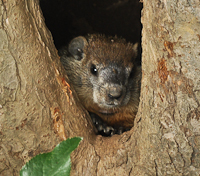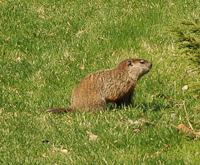 The largest of these pests is the
woodchuck.
The average adult's body is about 18 inches long followed by a
tail 4 to 5 inches in length. They weigh between 5 and 12
pounds and, although they generally feed on the ground, they
are good climbers and may be seen in trees or on split rail
fences sunning themselves.
The largest of these pests is the
woodchuck.
The average adult's body is about 18 inches long followed by a
tail 4 to 5 inches in length. They weigh between 5 and 12
pounds and, although they generally feed on the ground, they
are good climbers and may be seen in trees or on split rail
fences sunning themselves.
Woodchucks
live in dens in the ground which may have as many as 5
different openings. One or more of the openings will be in the
open and appear to be well-used but there will be others that
are hidden nearby for fast retreats.
 Unlike the
Eastern chipmunk which stores
nuts and seeds for winter feeding, the woodchuck relies solely
on body fat to survive the winter. They nod off into
hibernation in late fall and awaken again in the spring.
Unlike the
Eastern chipmunk which stores
nuts and seeds for winter feeding, the woodchuck relies solely
on body fat to survive the winter. They nod off into
hibernation in late fall and awaken again in the spring.
Reproduction occurs in mid to late April
with the average litter being 3 to 5 young. If woodchucks
become pests, it is better to control them prior to the
addition of the young who will eventually want to establish
burrows of their own in the area.



